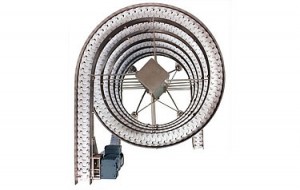Applied Automation launches conveyor at PPMA
 Using an Omron delta robot with vision system technology, Applied Automation used a robot challenge as part of a demo cell to launch a new range of conveyors at PPMA 2015.
Using an Omron delta robot with vision system technology, Applied Automation used a robot challenge as part of a demo cell to launch a new range of conveyors at PPMA 2015.
The demonstration introduced the Carryline flexible plastic chain conveyor, with the spiral conveyor featuring in a machine set-up with a robot spelling challenge. The conveyor was integrated with Omron technologies, which Applied Automation uses to develop complete automation, control and materials handling solutions.
The demonstration showed the robot picking pucks from the conveyor – each puck having a letter inscribed on it – and placing them to spell out a word.
Visitors to the stand initiated the ‘Spelling Challenge’ by selecting a word on the HMI screen adjacent to the cell. This information is fed to the vision system which scans the pucks as they pass beneath it. The pattern matching algorithm enables the vision system to identify the position of each puck, the specific letter it contains, and the orientation of the letter.
Each time a required letter is found, the positional and orientation data is fed to the delta robot, which picks the puck and positions it adjacent to the conveyor, repeating the action to spell out the required word.
All of this happens at high speed, with the conveyor not pausing for a moment to make it easy on the vision system and robot. Not that this is a problem: the vision technology is designed to provide a high function inspection system, with advanced pattern matching algorithms and high speed processing of image data. The delta robot, meanwhile can achieve up to 200 cycles per minute and can be synchronised with multiple conveyors to perform on-the-fly pick and place operations. All of this is under the control of a Sysmac NJ controller which offers sub millisecond response time when controlling a single delta robot, and the ability to control up to eight delta robots with a response time of just 2ms.
 Applied Automation managing director David Rowe says: “From a machine building point of view, it is important that control equipment should be easy to integrate, and that’s exactly what we get with the Omron technology. With the delta robot, motion control equipment, vision system, HMI and PLC all linking over EtherCAT communications, all programmed and configured using the same Sysmac software, even the most complex automation systems are easy to put together.
Applied Automation managing director David Rowe says: “From a machine building point of view, it is important that control equipment should be easy to integrate, and that’s exactly what we get with the Omron technology. With the delta robot, motion control equipment, vision system, HMI and PLC all linking over EtherCAT communications, all programmed and configured using the same Sysmac software, even the most complex automation systems are easy to put together.
“In addition, the fact that we can get all of this control equipment from a single source of supply has benefits from a logistics and support point of view.”
Flexible conveyors
The Carryline spiral conveyor is a space efficient configuration and, like all Carryline conveyors, can be built to the customer’s specification. The conveyors are easy to adapt and low maintenace, and there’s a choice of aluminium or stainless steel, six chain widths, and various chain types.
“We have ambitious plans for our Industrial Systems division and are pleased to add these conveyors to our product range,” says Rowe. “Applied is now the sole national agent for Carryline in the UK and Northern Ireland and we provide a full design and installation service.
“This was our first time at the PPMA Show so we were excited to be launching Carryline there and the robot challenge will be a bit of fun for visitors,” he continues. “The big message we picked up at the PPMA Show was that people want turnkey solutions. We were there to launch Carryline conveyors in the UK and we had a lot of interest, but visitors to our stand were asking for the extended integration services we offer as well. Many had imminent projects and wanted to discuss the available solutions, not just buy components.”
Visit the Applied Automation website for more information.
See all stories for Applied Automation
Previous page PPMA Show 2015 report Next page















